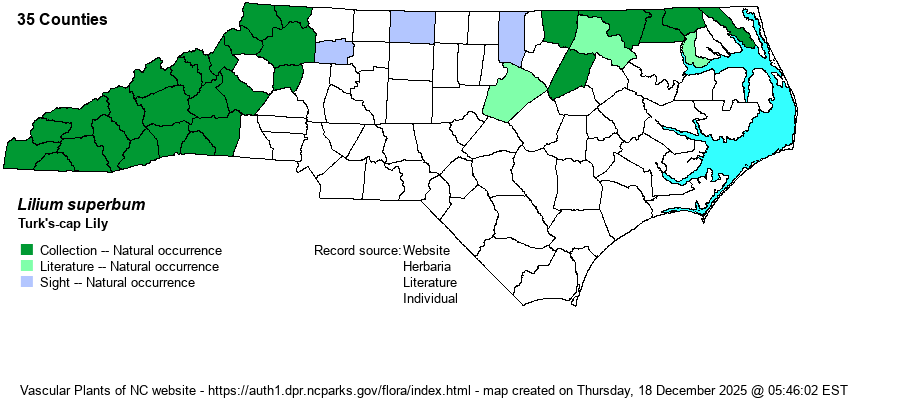| Author | L. | |
| Distribution | Throughout the Mountains and at a few western Piedmont monadnocks or other ranges. Also scattered in the northern Piedmont and northern Coastal Plain, south to Chowan, Nash, Wake, and Yadkin counties. These records for the northeastern Piedmont and northern Coastal Plain are of one or more very unsettled taxa, but for now are considered to be within this species.
Generally a species of the Northeast, occurring from MA, NY, and southeastern MO south in the Coastal Plain to northeastern NC. It is widespread in the central and southern Appalachians, to northern GA. It has a number of disjunct populations into the Coastal Plain of SC, GA, western FL, AL, and MS. The relatively large number of wide disjunctions in the southern part of the range are curious to say the least.
| |
| Abundance | Fairly common to locally common across the Mountains, and occurs at most elevations (high to low). However, it is very rare in the northern Piedmont, except rare in the northeastern portion and eastward in the Coastal Plain to Camden County. | |
| Habitat | In the Mountains and foothills, it is a characteristic and showy wildflower of Rich Cove Forests and other hardwood forests near or in shaded seepages. It can occur in moist ravines, and rarely in somewhat open and damp ground. Farther eastward, in the Piedmont and Coastal Plain, it grows -- oddly -- in swamps, generally in blackwater sites such as near or under Swamp Tupelo (Nyssa biflora). It does not grow in rich, brownwater swamps such as along and near the Roanoke River, but it is mostly found in very poorly drained wet shaded flats. | |
| Phenology | Blooms in July and August, and fruits in September and October. However, the plants in the northeastern Piedmont and Coastal Plain rarely flower. | |
| Identification | This is one of the most stately and spectacular of the state's wildflowers, as the stem grows normally to 6-7 feet tall, over the heads of most people. The leaves are in many whorls, with 5-20 narrowly elliptic to lanceolate leaves that tend to droop somewhat toward the tip. The top 1-2 feet of the stem is beset with often 10-25 or more large orange flowers, each on a long and dangling stalk, such that the flowers face downward. Each flower is about the size of a baseball, with the long stamens extending well beyond the strongly recurved tepals. It really has no other species that resembles it in most areas of the state; L. michauxii has similar flowers, but it is a shorter plant, grows in drier soil of upland forests, has thick and obovate leaves, and generally has just 1-3 flowers. The plants in the northeastern part of the state have been variously called L. superbum or L. pyrophilum. This latter species has leaves that do not droop at the tips and are usually angled upward; it grows in seepages on sloping ground, not in swampy flats. Weakley (2018) says that these northeastern lilies have yellow flowers, and their leaves are very narrow. However, plants photographed on iNaturalist from Halifax County have flowers essentially deep red! Observers should have little trouble spotting this species in the mountains, though many will be juveniles that will not bloom until a year or two later. In mid- to late summer, when driving along the Blue Ridge Parkway, you have a good chance of seeing the species in bloom from your car. | |
| Taxonomic Comments | Though this is certainly a good species, taxonomists have puzzled over what to name these swamp-dwelling plants in southeastern VA and northeastern NC. Some are willing to call them at least one, if not two or more, undescribed species. Some prefer to call them as undescribed varieties of L. superbum. However, no one has yet described them to provide a name. In fact, Weakley (2018) has simply subsumed all into L. superbum, at least for the meantime. NatureServe also has no undescribed forms for the species.
| |
| Other Common Name(s) | None | |
| State Rank | S4 | |
| Global Rank | G5 | |
| State Status | | |
| US Status | | |
| USACE-agcp | FACW link |
| USACE-emp | FACW link |

